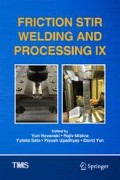Abstract
As an innovative hybrid joining process ultrasound enhanced friction stir welding (USE-FSW) was successfully applied on Al/Mg-joints and offers a beneficial impact on the resulting microstructure and mechanical properties. Whereas in conventional FSW of Al to Mg continuous band-shaped intermetallic layers of Al3Mg2 and Mg17Al12 are always present, the formation of these layers can be influenced positively by the ultrasound energy that is transferred into the stirred zone in USE-FSW. In this case, the intermetallic phases are spread over the complete nugget zone. Consequently, the tensile strength increases about 25% and the fatigue strength rises by up to 3.5 times. Based on this USE-FSW was investigated with regard to possible advantages for Al/steel-hybrid-joints. Preliminary investigations have shown significant differences in the microstructure of ultrasound enhanced and non-ultrasound enhanced EN AW-6061/DC04-joints. While conventional FSW led to hooks and larger particles of steel in the aluminum, USE-FSW-joints show remarkably smaller and more homogenous distributed steel particles in the nugget. Beside mechanical investigations, non-destructive examinations and corrosion tests were carried out.
References
Khaled T (2005) An outsider looks at Friction Stir Welding. Federal Aviation Administration, Lakewood
Straß B (2015) Ultraschallunterstütztes Rührreibschweißen von Al/Mg-Verbunden: Prozessanalyse, mikrostruktureller, mechanischer und korrosiver Eigenschaftsvergleich. Dissertation TU Kaiserslautern
Klag O (2013) Mikrostruktur, mechanische Eigenschaften und Korrosionsverhalten rührreibgeschweißter AZ91/AZ91- und AZ91/AlMg3Mn-Verbunde. Dissertation TU Kaiserslautern
Reinhold B, Blücher D, Korte M (2013) Herausforderungen an Füge- und Oberflächentechnik für zukünftige Leichtbaukonstruktionen im Automobilbau—Challenge of joining and surface technologies for light weight constructions in automobile applications. Materialwiss Werkstofftech 44:58–69
Benfer S, Straß B, Wagner G, Fürbeth W (2016) Manufacturing and corrosion properties of ultrasound supported friction stir welded Al/Mg-hybrid joints. Surf Interface Anal 48(8):843–852. doi:10.1002/sia.5871
Park K (2009) Development and analysis of ultrasonic assisted friction stir welding process. Dissertation, Department for Mechanical Engineering, University of Michigan
Acknowledgements
We would like to thank the “German Research Foundation (DFG)” for the support of the present work as a part of the Priority Program 1640 “Joining by Plastic Deformation”.
Author information
Authors and Affiliations
Corresponding author
Editor information
Editors and Affiliations
Rights and permissions
Copyright information
© 2017 The Minerals, Metals & Materials Society
About this paper
Cite this paper
Thomä, M. et al. (2017). Realization of Ultrasound Enhanced Friction Stir Welded Al/Mg- and Al/Steel-Joints: Process and Robustness, Mechanical and Corrosion Properties. In: Hovanski, Y., Mishra, R., Sato, Y., Upadhyay, P., Yan, D. (eds) Friction Stir Welding and Processing IX. The Minerals, Metals & Materials Series. Springer, Cham. https://doi.org/10.1007/978-3-319-52383-5_19
Download citation
DOI: https://doi.org/10.1007/978-3-319-52383-5_19
Published:
Publisher Name: Springer, Cham
Print ISBN: 978-3-319-52382-8
Online ISBN: 978-3-319-52383-5
eBook Packages: Chemistry and Materials ScienceChemistry and Material Science (R0)

